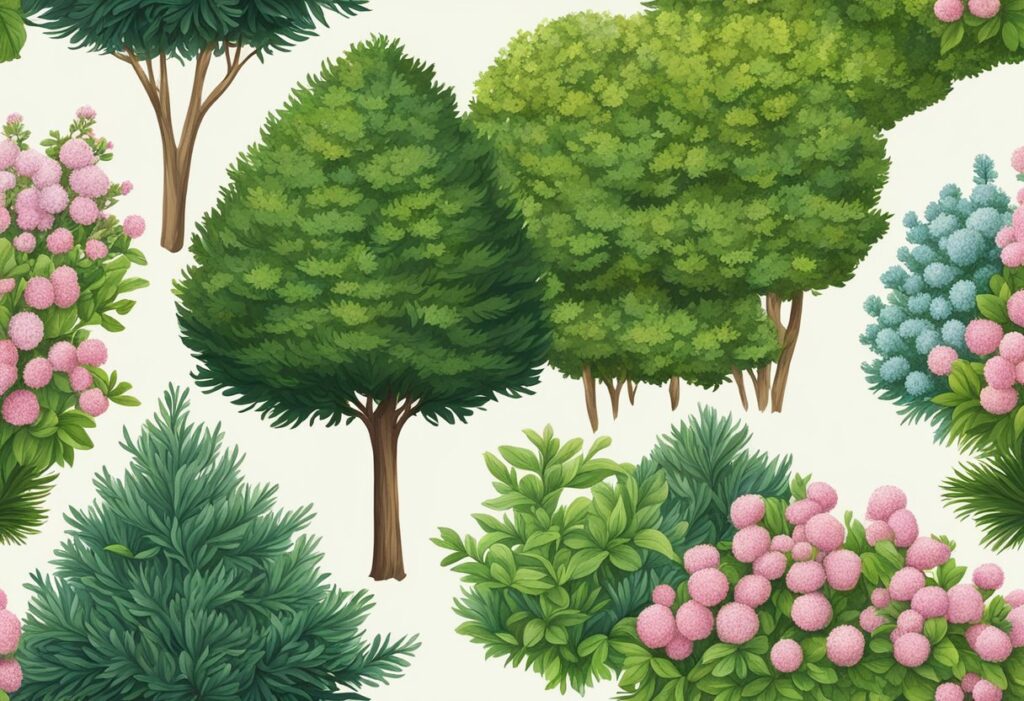Flowering Evergreen Shrubs: Top Choices for Year-Round Color
Flowering evergreen shrubs are a versatile and valuable addition to any landscape. These hardy plants offer year-round beauty with their lush foliage, vibrant blooms, and low maintenance requirements. Many evergreen shrubs are designed to thrive in various climates and soil types, making them a practical option for gardeners looking to enhance their outdoor spaces.

There are numerous varieties of flowering evergreen shrubs available, each with their unique characteristics. Some popular species are well-suited to small gardens or containers, while others serve as focal points or natural screens for larger areas. Regardless of size and function, all flowering evergreen shrubs provide visual interest throughout the year, serving as a constant source of color and texture.
Key Takeaways
- Flowering evergreen shrubs offer year-round beauty with minimal maintenance
- Many varieties are suitable for different garden sizes and purposes
- Proper planting and care ensure healthy, thriving plants
Understanding Flowering Evergreen Shrubs
Evergreen shrubs are a popular choice for gardens due to their year-round foliage and color. Flowering evergreen shrubs offer both beauty and functionality, providing a welcoming and vibrant touch to your landscape. In this section, we’ll cover the different aspects of flowering evergreen shrubs, discussing their types, color variations, seasonal changes, and other plant characteristics.
Types of Evergreen Shrubs
There are many types of flowering evergreen shrubs to suit various growing conditions and preferences. Some popular examples include:
- Azalea and Rhododendron: These are both members of the same genus and are known for their showy, colorful flowers and preference for acidic soil. They thrive in partial shade and well-drained soil.
- Camellia: Known for its glossy green leaves and large, rose-like flowers, this shrub prefers acidic, moist, and well-draining soil.
- Holly: Producing red berries and dark green, glossy leaves, holly is an excellent choice for borders, hedging, and screening.
- Pieris: Also known as Japanese Pieris or Mountain Laurel (Kalmia latifolia), this shrub has bell-shaped flowers and does well in acidic soil with partial shade.
- Gardenia: With its fragrant, creamy-white flowers and glossy green leaves, gardenias are a beautiful addition to any garden. They require full to partial sun and well-drained, acidic soil.
Color Variations
Flowering evergreen shrubs come in a wide range of colors, providing a delightful visual interest throughout the year. Depending on the variety, flowers can be found in shades such as pink, white, red, purple, yellow, bronze, and even variegated patterns. Foliage also varies, ranging from golden to purplish, dark green, and even variegated leaves.
Seasonal Changes
While some flowering evergreen shrubs bloom in spring, others produce flowers during summer or winter months. It’s crucial to choose the right variety based on your garden’s needs, ensuring year-round color and interest. For example:
- Spring: Azalea, Rhododendron, and Japanese Pieris are popular choices for spring-blooming shrubs.
- Summer: Abelia and Gardenia Jasminoides provide vibrant colors and fragrance throughout the summer months.
- Winter: Some winter-blooming options include Daphne and Camellias, which offer lovely, fragrant flowers as a welcome contrast to the colder weather.
Other Plant Characteristics
Apart from their flowers and foliage, other characteristics to consider when choosing flowering evergreen shrubs for your garden are:
- Size: Some shrubs are suitable as foundation plants, hedges, or ground cover, while others may be larger and better suited for mass plantings, screening, or privacy.
- Light requirements: While many evergreen shrubs prefer partial shade or partial sun, some varieties, like Boxwood and Wintercreeper, can tolerate full sun.
- Hardiness zone: Be sure to choose plants that are suitable for your region’s USDA hardiness zone, ensuring that your shrubs will thrive in your garden’s climate.
- Growth rate: Some shrubs, like Lilacs and Cherry Laurels, are fast-growing and can quickly fill a space, while others may require more patience.
When selecting flowering evergreen shrubs for your landscape, considering the plant’s characteristics, growing conditions, and personal preferences will ensure a long-lasting, pleasing addition to your garden.
Planting and Caring for Flowering Evergreen Shrubs
When it comes to planting flowering evergreen shrubs, we need to consider various aspects such as soil type, hardiness zones, and the specific requirements of each plant. In general, these shrubs prefer acidic, well-drained soil and can often be low-maintenance, making them an excellent addition to any garden.
Before planting, it’s essential to choose the right location. Many flowering evergreen shrubs thrive in partial shade, but some may also tolerate full sun. Make sure to place them in areas where they can receive the appropriate amount of sunlight for their needs. Additionally, consider the mature size of the shrub when selecting a planting site to ensure ample room for growth.
The soil is another critical factor for these shrubs. Many of them prefer acidic soil; therefore, it may be necessary to amend your garden soil with peat moss or other organic matter to lower the pH. Well-drained soil is also crucial for the healthy growth of these plants, as waterlogged roots can lead to various issues, including root rot.
During the planting process, dig a hole about twice the width of the shrub’s root ball and slightly deeper. Gently remove the plant from its container and loosen the roots if they are tightly bound. Place the shrub in the hole, making sure it is level with the soil surface, and then backfill with soil, firming gently around the roots.
Once planted, provide regular water to establish a robust root system. Flowering evergreen shrubs typically do not require constant irrigation but benefit from a deep soak during extended periods of dry weather. Mulching around the shrub base can help to retain soil moisture and maintain a consistent soil temperature.
Some popular flowering evergreen shrubs offer various benefits, such as fragrant white flowers or attractive foliage. For example, a dwarf variety of these plants can be an excellent choice for hedges, borders, or other tight spaces in the garden. They can add visual interest to the landscape and often exude a delightful fragrance or display vibrant blooms throughout the year.
In conclusion, by carefully considering planting conditions and providing proper care, we can successfully incorporate flowering evergreen shrubs into our gardens. These plants offer numerous benefits, such as year-round foliage, beautiful blooms, and in some cases, enchanting fragrances, making them an exceptional addition to any gardening endeavor.
